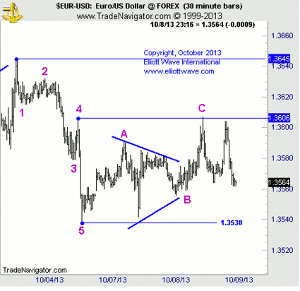Vadim Pokhlebkin of ElliottWave.com shows how the surging demand for US dollars might impact the Eurodollar cross and other forex markets.
October 8, Reuters—“Demand for dollar cash outside the United States surged on Tuesday, with market participants paying sharply higher premiums to get their hands on dollars to tide them over a mid-October deadline to raise the US borrowing limit.”
What does this mean for the USD’s exchange rate against other currencies?
Well, on the surface, high dollar demand should be bullish for the buck: Rising demand equals rising prices. But what if the US government shutdown ends tomorrow? Will the dollar immediately reverse as the demand for it falls?
As usual, Elliott wave analysis gives you some much needed objectivity at a highly uncertain time.
You see from this chart that for most of October, EUR/USD, the most-traded forex market, has gone sideways.
The sideways trading has the look and feel of an Elliott wave correction: an overlapping, choppy move. That’s why we have labeled it ABC.
But notice that the preceding move was much more directional, and with less internal overlap. That looks like an Elliott wave impulse—and it’s labeled just that: 12345.
What does this all mean? Well, impulses unfold in the direction of the larger trend. Corrections provide pauses within that trend.
We have said before on these pages that news and events may add to short-term volatility, but they don't change the broad trend. That trend is set by the bias and mood of the traders.
Right now, forex traders are betting on the unknown outcome of the US government shutdown. You can't know how and when it will be resolved. But you can know which way traders' collective biases are leaning. All you need to do is look at Elliott wave patterns in price charts.
By Vadim Pokhlebkin of ElliottWave.com



















